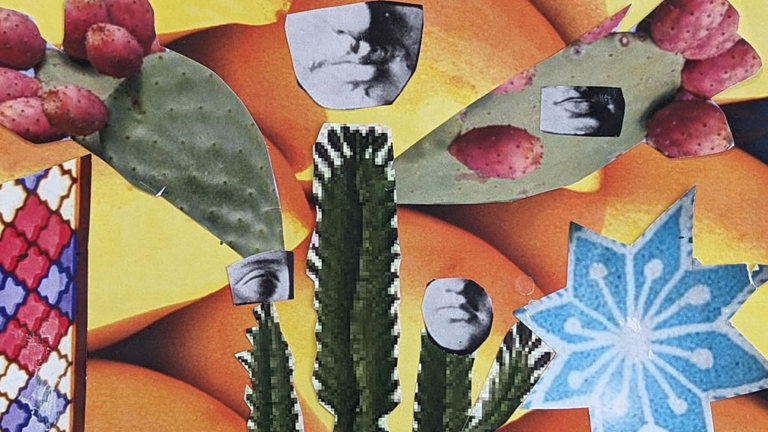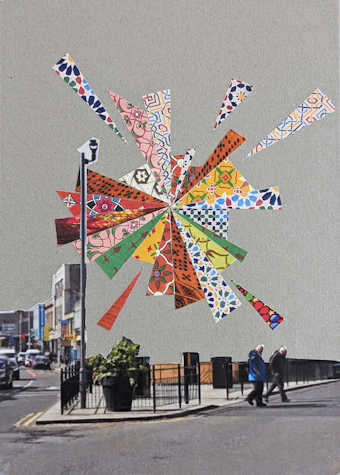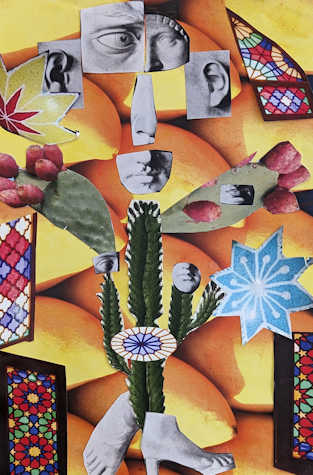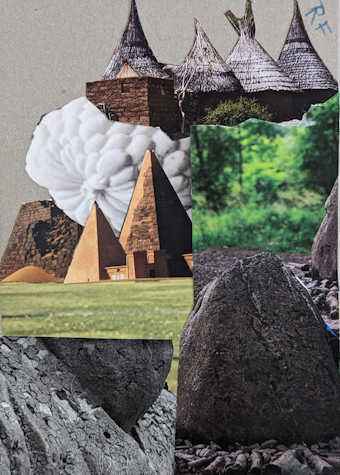Paria Goodarzi, Mia Gubbay, Francesca Zappia & Maryhill Integration Network Art Group
Beauty Osayomwanbor Nosa, Inna Hordiiko, Mehri Abdi, Rezvan Faghani, Sara Abdelnasser, Shahid Mahmood, Sadaf Syeda, Tanisha Sarkar, Tara Gomary, Tomilola Owolabi, Valentina Vodolazska and Valentyna Dolottseva are part of the Maryhill Integration Network Museum of Things Art Group, a creative space for people seeking asylum and refugees in Glasgow. Weekly sessions, led by artists Paria Goodarzi and Mousa Al Nana since 2021, provide a platform for participants interested in developing skills and accessing creative opportunities by engaging with the local cultural landscape. This forms part of a process of social integration, enabling them to express and incorporate their individual voices, heritage and lived histories into new collective artworks.
Francesca Zappia is an Italian curator and researcher based in Glasgow. Her work explores the potentialities of artistic and curatorial research in passing on cultural memory and producing fresh knowledge. Her practice takes a context-specific approach that develops through long-term conversations with artists, students, and communities and results in artwork commissions. Reflecting on the curator's responsibility to connect art and audiences, besides organising exhibitions, she explores new ways of dissemination, online, on paper, or through discursive events.
Since being awarded a curatorial research grant from the Centre National des Arts Plastiques, Paris, Francesca has focused on original and innovative ways of rethinking the value of artwork reproductions in art and heritage. Her book ‘Flâneurs’ (2023) summarises the research carried out in the CNAP collection. She is also a PhD candidate at the Glasgow School of Art, where she works to reimagine pedagogical values for the school's plaster cast collection, and an invited researcher with the Haute Ecole d’Art et Design (HEAD), Geneva, to contribute to a research project that deconstructs and futures understandings of the ‘original’.
Mia Gubbay is a heritage consultant whose work focuses on collaborative practices including co-curation and co-collecting. Themes of this work include migration, trans-location and collective re-imagining of place. Mia’s family histories of movement, entangled with legacies of British and Dutch imperialism in the Middle East and Southeast Asia, help her to connect with the strengths, poetry and stories of other communities whose experiences have been written out of history. Mia collaborates with a wide range of heritage, academic and creative practitioners, often within the context of third sector and community-led organisations. She facilitates and coordinates the co-design of platforms for sensitive, meaningful dialogue.
Current and recent projects include Traces of Empire Historic Environment Scotland, curator, 2023-24; Our Power Mental Health Foundation curator, 2024; Lessons in Welcome Scottish Refugee Council, consultant, 2022-2023; Tilal with the Rediscovering the Antonine Wall project for West Dunbartonshire Council and Historic Environment Scotland consultant, 2022; Assistant Curator of the Migration Collections Project at Glasgow Museums 2018-2020. Mia studied at Central Saint Martins College of Art and Design and the Institute of Archaeology, UCL.
Paria Goodarzi is a visual artist and social art practitioner, member of UNESCO RILA Affiliated Artist network, and the Young Academy of Scotland. Paria studied BA Textile Design at the University of Science & Culture in Tehran, Sculpture & Environmental Art at Glasgow School of Art, and a Masters in Adult Education, Community Development, & Youth Work at Glasgow University.
Her work focuses on cultural and political transfers, translocations, and ideas of the contemporary human condition, cultural identity, and displacement. Paria examines the processes of formation, and representation of identity through a multidisciplinary practice that often takes the form of collaborative, participatory and socially engaged artworks. As part of her community and socially engaged art practice, she targets a broad audience of diverse social backgrounds and ages, responding to ideas around identity and representation. Exploring social and political issues through participatory and collective engagement and creative thinking with the aim to make a positive impact on the long-term wellbeing and visibility of minority groups to promote integration and diversity.
Projects
-
ProgrammeMonuments for the Present






